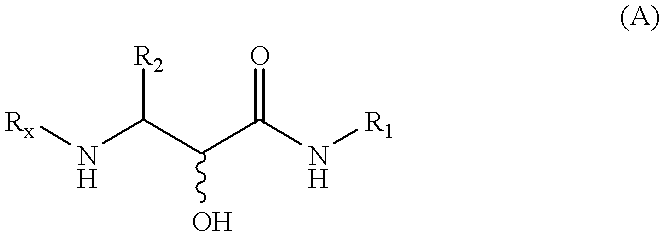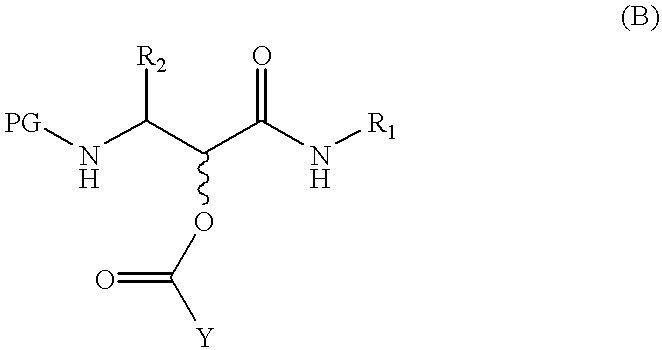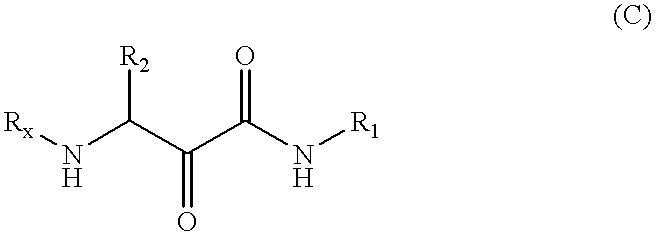Methods for the synthesis of alpha- hydroxy-beta-amino acid and amide derivatives
- Summary
- Abstract
- Description
- Claims
- Application Information
AI Technical Summary
Benefits of technology
Problems solved by technology
Method used
Image
Examples
second embodiment
the present invention, termed the Complex Scheme and outlined in FIG. 7 / Scheme 5, includes further extensions of the Passerini reaction which Applicants have developed. This embodiment provides an .alpha.-hydroxy-.beta.-amino acid derivative 7-5 or an .alpha.-ketoamide derivative 7-6, wherein PG, R.sub.1, R.sub.2, and R.sub.3 are as defined in connection with formula (A).
According to this embodiment, a tandem three-step process is executed which involves a sequential addition reaction, a-amino group deprotection, and adjustment of the reaction solution pH to about 6 to 9, wherein an acyl migration ensues. Each step of this tandem process occurs with high efficiency and under mild conditions. Thus, the addition reaction of protected .alpha.-aminoaldehyde 7-1 with an isonitrile R.sub.1 NC and a carboxylic acid R.sub.3 CO.sub.2 H in a suitable solvent, e.g., methanol, ethanol, dichloromethane, tetrahydrofuran or mixtures thereof, over a temperature range of about -20.degree. C. to abou...
examples 5 , 7
Examples 5, 7, and 8 describe semicarbazone protection and deprotection of ketoamide made using the TFA reactions. The teachings of those examples, as well as that available in the art, is applied to practice semicarbazone protection and deprotection of ketoamides made using the Complex reactions (Complex Methods III and III').
8. General Reaction Conditions
Reaction progress is routinely monitored by conventional analytical techniques such as RP-HPLC or TLC analysis (silica gel; UV, PMA visualization; EtOAc, hexane; ether, hexane, dichloromethane, hexane; dichloromethane, ethyl acetate mixtures); dichloromethane, methanol mixtures; dichloromethane, isopropanol mixtures.
9. Preferred Selections of R.sub.1, R.sub.2, and R.sub.3
Methods of the present invention are preferably used to synthesize inhibitors of serine proteases and inhibitors of cysteine proteases. Preferred inhibitors are those that target thrombin, Factor Xa, NS3 protease of Hepatitis C Virus, calpain, and aspartyl proteas...
example 1
Synthesis of Protected Amino Acid Starting Materials Used in Methods TFA-I, Complex I, and Complex V
Protected amino acid derivatives are converted into protected .alpha.-aminoaldehyde derivatives following the procedures outlined below and those employing procedures known in the art. Starting materials within the noted structural formulas are commercially available and / or may be synthesized using conventional methods. In each case, the noted protocol yields a protected .alpha.-aminoaldehyde derivative that may be used in either or both the TFA and Complex reactions, for which examples are provided herein below.
.alpha.-Aminoaldehydes primarily are obtained from .alpha.-amino acids. The synthetic route for these compounds usually proceeds via esters or active amides of .alpha.-amino acids, which are then reduced. A second approach is based on .alpha.-amino alcohols obtained from .alpha.-amino acids, which are oxidized to afford the desired .alpha.-amino aldehydes. Detailed summaries o...
PUM
| Property | Measurement | Unit |
|---|---|---|
| Fraction | aaaaa | aaaaa |
| Fraction | aaaaa | aaaaa |
| Fraction | aaaaa | aaaaa |
Abstract
Description
Claims
Application Information
 Login to View More
Login to View More - R&D
- Intellectual Property
- Life Sciences
- Materials
- Tech Scout
- Unparalleled Data Quality
- Higher Quality Content
- 60% Fewer Hallucinations
Browse by: Latest US Patents, China's latest patents, Technical Efficacy Thesaurus, Application Domain, Technology Topic, Popular Technical Reports.
© 2025 PatSnap. All rights reserved.Legal|Privacy policy|Modern Slavery Act Transparency Statement|Sitemap|About US| Contact US: help@patsnap.com



